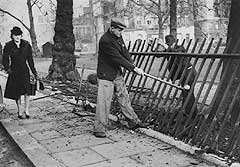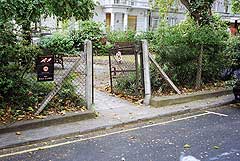See also

"All wrought iron had been removed from public places for use in the war
effort. Streets were denuded of gates, railings and anything
else not serving an essential purpose. Our trudge up the steep hill of
Erlanger Road to my grandparents' house evokes the memory,
not only of aching legs but of the stubs of metal at the edge of the
front gardens that had formerly been graced by wrought iron
railings. "
Rosemary Radley, Blackheath,
BBC2 Wartime People's War,
Contribution: November
2003

"Many London squares were stripped of their historic railings in
1941 and are still enclosed by ugly chain link fencing. The Crown
Estate's superb reinstatement of the railings to Park Square East and
West, plus the new gates to Regent's Park (following the original
designs) has transformed one of London's greatest architectural set-
pieces.

"Most recently [we have seen] the completion of works to restore Brunswick
and Bloomsbury Squares. Both are included within the English
Heritage Register of Parks and Gardens of Special Historic Interest
and both have been awarded grants. The works included new
planting, path repairs, new furniture and, at Brunswick Square, the
reinstatement of the impressive perimeter railings and gates.
"The works complement the landscape works recently completed at the
adjoining Coram's Fields to restore elements of the historic
landscape and provide new play facilities."
English Heritage Website
www.english-heritage.org.uk
In 1940, during WW2, Prime Minister Winston Churchill appointed press
baron Lord Beaverbrook to be his Minister of Supply and
Beaverbrook set about the task with his customary zeal. Underground
munitions factories were set up in old mines and in July
Beaverbrook launched a press campaign for the public to donate aluminium
pots and pans to make fighter aircraft: "We will turn
your pots and pans into
Spitfires and Hurricanes, Blenheims and Wellingtons." The public
responded by donating over 70,000 tons of aluminium, a good
percentage of which was recycled in aircraft production.
Beaverbrook also identified a need for heavier raw materials like iron
and steel for munitions. In 1941 the government passed an
order compulsorily requisitioning all post-1850 iron gates and railings
for the war effort, with a few exceptions made for items of
particular historic interest, usually elaborate gates.
Eye witnesses reported council workmen arriving with sledgehammers,
cutting equipment and lorries, taking everything in their path,
leaving only stubs. The iron was loaded onto council lorries and driven
off, supposedly for despatch to steel works around the UK,
where it would be melted down and recycled.
In fact the fate of much of the cut down ironwork remains a mystery and
there is considerable scepticism over how much iron was
recycled for munitions and how
was much merely dumped (see Whatever Happened to our
Railings?).
The loss of this ironwork was keenly and long felt and replacing lost
iron railings with traditional style replicas is often the first
objective of
any restoration. To meet the demand for replacing lost iron gates and
railings, a number of specialist ironwork firms will supply ironwork
made using traditional techniques and designs. Many of
the original pattern books have survived and can be used to choose
a style for a modern railing using traditional materials.

Replacement gates to Regent's Park at Park Square East. By
the early 20th century, the original John Nash gates and railings at Park Square
were in a poor state and were replaced with utilitarian versions. Work to
replace them in the original style was completed in 2002, when the new gates
were opened by HRH the Prince of Wales.
Victorian and. Edwardian railings were made by casting iron in
sand moulds and finished with a decorative finial on the top of each
rail. Cast iron, although more brittle, seems more resistant to
corrosion than wrought iron, possibly because of its foundry skin
and higher
carbon content. Wrought iron railings of any age are generally
covered in paint and liable to a build-up of rust in water although
properly cared for wrought iron will last just as well if not better than
cast iron. Gates and window balconies often featured swirling
wrought iron decorative motifs.
When deciding to restore the gate or railings around a park or
garden, any historical records of the appearance of the original
ironwork will be very useful. If any part of the original railings has
survived, this can be analysed for the original paint type and colour.
Wrought Iron and Cast Iron
Wrought iron is made by heating the material to red heat in a furnace
and then hammering it on an anvil.
Historically, wrought iron was made by a special process that
included slag which was beaten into the iron to give a grained
appearance, making the finished product almost resemble wood.
This grained wrought iron had a very high tensile strength. At one
point wrought iron was used for almost all quality ironwork in
construction.
Cast iron is a hard, brittle,
non-malleable iron-carbon alloy, cast into shape, containing 2 to 4.5
percent carbon, 0.5 to 3 percent silicon, and lesser amounts of
sulphur, manganese, and phosphorus.
It is made by remelting pig iron, often along with substantial quantities
of scrap iron and scrap steel. The final shape is achieved by pouring
the iron into moulds.
Traditional Victorian cast iron was made by sand-casting, where the
molten liquid was poured into a sand-based mould and left to cool.



